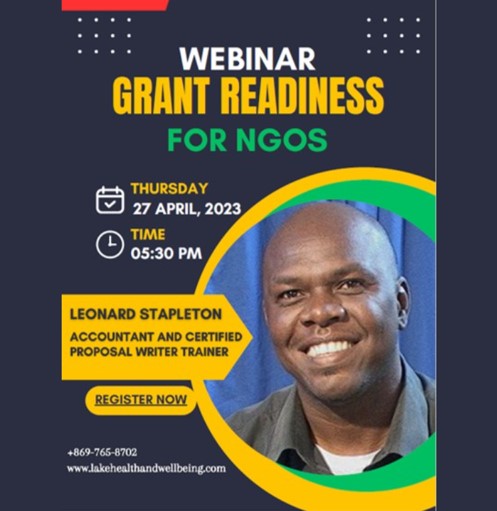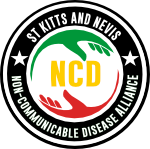- info@sknncdalliance.com
Grant Writing Webinar for NGOs
Last Updated on September 16, 2023

Grant writing is a crucial skill for non-profit organizations working in the field of non-communicable diseases (NCDs). As the prevalence of NCDs continues to rise, the need for funding to support prevention, treatment, and research efforts has become more important and for NGOs to attract the funding they need, they need to perfect their grant-writing skills.
One of the focus areas of the St Kitts and Nevis NCD Alliance is to build the capacity of NGOs and thus on 27th April 2023, we hosted our first capacity-building webinar which focused on grant readiness for NGOs featuring guest speaker, Accountant and Grant Writing Trainer, Mr. Leonard Stapleton.
Overview of the Session and Lessons Learnt
Mr. Stapleton highlighted that it is important to note that grant writing is not a one-size-fits-all approach. Each funding opportunity requires a unique approach, tailored to the specific funder’s guidelines and priorities. Successful grant writers adapt their proposals to match the funder’s expectations while showcasing their organisation’s capacity and competence.
Before diving into the intricacies of grant writing, it is essential to have a clear understanding of the grant writing process. This process typically consists of several key stages that organisations need to navigate in order to secure funding.
The first stage is research and planning, where NGOs identify potential grant opportunities and thoroughly research the funding organisation’s priorities and requirements. This step is crucial as it helps organisations align their proposals with the funder’s goals, increasing their chances of success.
It is crucial for NGOs to focus on the research and planning stage. This stage not only lays the groundwork for successful grant writing but also helps organisations identify the most suitable funding opportunities for their projects.
To begin, NGOs should invest time in researching and identifying potential grant opportunities. Start by exploring both government and private funding sources that align with your organisation’s mission and objectives. Make a list of potential funders and take note of their priorities, funding cycles, and requirements.
Once you have a list of potential funders, the next step is to thoroughly research each organisation’s priorities and requirements. Dive deep into their mission and vision, funding priorities, and any specific criteria they have for grant applications. This research will enable you to tailor your proposals and increase your chances of securing funding.
Additionally, it is essential to consider the funding organisation’s geographic scope and target population. Some funders may focus on local initiatives, while others may have a national or international reach. Understanding these aspects will help you select the most relevant opportunities and ensure your proposals align with the funder’s goals.
Mr. Stapleton further highlighted that networking and building relationships with potential funders can be very useful. Attend industry conferences, workshops, and meetings where funders are present. Engage in conversations, showcase your organisation’s work, and establish meaningful connections. These connections can provide valuable insights, increase your organisation’s visibility, and potentially lead to partnerships or funding opportunities.
Developing a Compelling Proposal
Once potential funders have been identified, the next stage involves developing a compelling proposal. This includes clearly articulating the organisation’s mission and goals, outlining the proposed project’s objectives and outcomes, and establishing a realistic budget.
Writing a successful grant proposal requires a combination of skill, strategy, and creativity. Mr. Stapleton provided guidance on how to effectively communicate their mission, objectives, and project outcomes to attract funders’ attention and support.
- Break down your goals into measurable objectives and outcomes and specify the indicators you will use to track progress.
- When crafting your project description, provide a detailed overview of your activities, timeline, and budget. Be specific about how funding will be utilised and demonstrate a cost-effective approach.
- It is crucial to articulate the sustainability and scalability of your project. Show funders that your organisation has a long-term vision and a plan for continued impact beyond the term of the grant. Highlight any partnerships or collaborations that strengthen your project’s feasibility.
- Lastly, pay close attention to the grant application guidelines. Tailor your proposal to meet the funder’s requirements and format. Ensure that your writing is concise, well-structured, and free from errors. Use visuals, such as charts or graphs, to enhance clarity and visual appeal.
When it comes to grant proposals, a well-crafted case for funding is the key to capturing the attention of potential funders. Start by clearly articulating the problem or need that your organisation aims to address. Utilise data, statistics, and case studies to provide evidence of the widespread impact of non-communicable diseases and how your organization’s work can make a difference.
Next, outline your organization’s goals, objectives, and strategies to tackle the identified problem. Explain how your interventions are evidence-based and align with national or global health policies and frameworks. Emphasize the unique strengths and expertise that your organization brings to the table and how it differentiates you from other applicants.
Furthermore, clearly define your target population and outline how your proposed activities will directly benefit them. Demonstrate a deep understanding of their specific needs, challenges, and aspirations, and how your interventions will address these effectively.
Finally, outline a comprehensive budget that details how the funding will be utilized and distributed across various project components. Provide a clear breakdown of costs, ensuring that they are realistic and justifiable.
Conclusion
Overall, building a strong case for funding requires a combination of compelling storytelling, data-driven evidence, and strategic alignment with funders’ priorities. By effectively conveying the value and impact of your organization’s work, you greatly enhance your chances of securing the funding needed to drive positive change in the field of non-communicable diseases.
Search
Events
ABOUT US
The St Kitts and Nevis NCD Alliance is a coalition of civil society organisations focused on the prevention and control of NCDs through public education, supporting NCD patients, advocating for evidence-based NCD policies and building the capacity of our members.
Add Your Heading Text Here
CONTACT DETAILS
Contact details: 1 869 765 8702 (WhatsApp)
Email address: ncdallianceskn@gmail.com
Email address: ncdallianceskn@gmail.com

